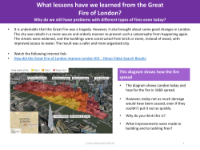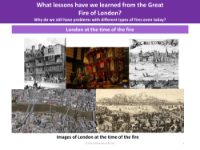How did the Great Fire of London improve the capital? - Presentation

History Resource Description
The Great Fire of London, which ravaged the city in 1666, inadvertently led to significant improvements in the capital's infrastructure and fire safety measures. Prior to the fire, London was densely populated with narrow, dusty streets and wooden houses built in close proximity, creating a fire hazard. The use of candles and open fires within these homes exacerbated the risk. After the fire, which started in a bakery on Pudding Lane and destroyed landmarks like London Bridge and St. Paul's Cathedral, the city was reconstructed with a focus on safety and order. Streets were widened, and buildings were made from brick or stone instead of wood, greatly reducing the likelihood of such a disaster reoccurring. These changes also included better access to water, contributing to a safer and more structured urban environment.
Despite the advancements post-Great Fire, the presentation prompts students to consider why fires remain a problem today. It includes an activity where children view a diagram showing the extent of the fire's spread and compare it to modern-day London, discussing why a similar event today would not cause as much damage. This leads to an exploration of the improvements made in building design and fire-fighting techniques since the 17th century. The presentation also encourages reflection on the enduring lessons from the Great Fire, asking students to summarise the main improvements made to London after it was rebuilt and to think critically about ongoing challenges in fire prevention and safety.





